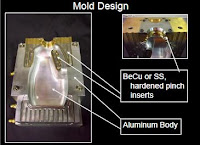A safety factor (SF) or factor of safety (FS) (also called factor of ignorance) is used with plastics or other materials (metals, aluminum, etc.) to provide for the uncertainties associated with any design, particularly when a new product is involved with no direct historical performance record. There are no hard and fast rules to follow in setting a SF. The most basic consideration is the consequences of failure. In addition to the basic uncertainties of graphic design, a designer may also have to consider additional conditions such as: (1) variations in material property data (data in a table is the average and does not represent the minimum required in a design); (2) variation in material performance; (3) effect of size in stating material strength properties; (4) type of loading (static, dynamic, etc.); (5) effect of process (stress concentrations, residual stress, etc.); and (6) overall concern of human safety.
The SF usually used based on experience is 1.5 to 2.5, as is commonly used with metals. Improper use of a SF usually results in a needless waste of material or even product failure. Designers unfamiliar with plastic products can use the suggested preliminary safety factor guidelines in Table 7.3 that provide for extreme safety; intended for preliminary dcsign analysis only. Low range values represent applications where failure is not critical. The higher values apply where failure is critical. Any product designed with these guidelines in mind should conduct tests on the products themselves to relate the guidelines to actual performance. With more experience, more-appropriate values will be developed targeting to use 1.5 to 2.5. After field service of the preliminary designed products has been obtained, action should be taken to consider reducing your SF in order to reduce costs.
Plastics
Engineered
Product
Design
Dominick Rosato and
Donald Rosato
ELSEVIER
















